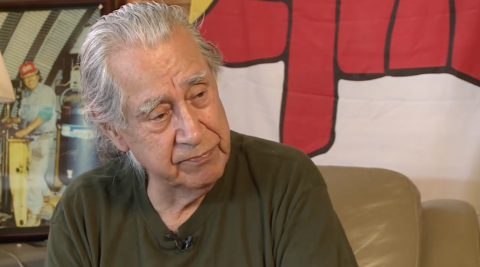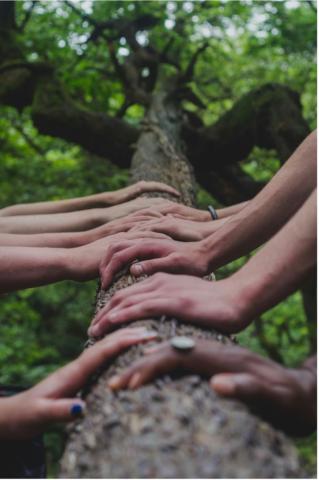Warrior Lawyer Profile: Albert Marshall

Elise Thorlacius
Allard JD 2025
May 14, 2025
Bridging Legal Worlds through Two-Eyed Seeing

Albert Marshall is a Mi’kmaw Elder, advocate, and bridge-builder who has dedicated his life to environmental stewardship and fostering cross-cultural understanding. A respected leader from Unama’ki (Cape Breton) and member of the Moose Clan, Marshall has worked tirelessly towards the resurgence and reclamation of Mi’kmaw language, culture and knowledge, while championing sustainability and emphasizing the responsibilities humans have to the Earth, non-human entities, and future generations.
Bridging Worlds
Born in 1938, Marshall has walked in many worlds and touched many lives. He is a survivor of the Shubenacadie Indian Residential School, where he was taken from his family and forced to spend much of his childhood and adolescence. Established by the Canadian government and operated by churches, the residential school system was used to carry out a genocide against Indigenous Peoples for more than 160 years.
The system was explicitly designed to strip Indigenous children of their language and culture and assimilate them into European-Canadian society. This experience profoundly impacted Marshall, shaping his lifelong journey to reconnect with the culture from which he was forcibly separated and to better understand the culture that was imposed upon him.
Marshall credits his wife, Murdena Marshall, for being a pivotal teacher and guide in his reconnection with Mi’kmaw language and culture. An exceptional and accomplished individual herself, Murdena has worked alongside Albert to develop and advocate for Etuaptmumk/Two-Eyed Seeing, a concept which Albert famously coined and has dedicated much of his life to teaching others.
The “gift of multiple perspectives”
Etuaptmumk/Two-Eyed Seeing encourages individuals to view the world through multiple lenses, embracing diverse cultural knowledges and perspectives to support collaboration and promote better outcomes. Marshall explains Etuaptmumk/Two-Eyed Seeing as “learning to see from one eye with the strengths of Indigenous knowledges and ways of knowing, and from the other eye with the strengths of Western knowledges and ways of knowing, and to using both these eyes together, for the benefit of all.”
As a passionate advocate for the environment and the chosen and leading voice for the Mi’kmaw Elders of Unama’ki on matters related to the environment, Marshall has championed Etuaptmumk/Two-Eyed Seeing as a transformative approach to address environmental harms and promote collective responsibility and sustainability. This principle has gained traction in academic, legal, and policy discussions, particularly in the fields of conservation, natural resource management, and education.

Weaving Knowledge into Action
A key aspect of Marshall’s advocacy is rooted in the Mi’kmaw legal principle of Netukulimk, which emphasizes the responsibility to live in harmony with the natural world and manifested in legal processes that sustain relationships with the environment and its inherent rights.
In a conversation with Silver Donald Cameron for the Green Interview, Marshall explains Netukulimk “gives you the opportunity to be able to sustain yourself by utilizing, harvesting the gifts from the land but without compromising the ecological integrity of the area and without compromising the sacredness of life.” This guiding principle has shaped Marshall’s environmental advocacy, particularly following his own personal experience.
In the 1970s, Marshall and his family suffered severe health effects following their exposure to the same toxic herbicide mixture that the US military sprayed over massive areas of Southeast Asia during the Vietnam War under the code name Agent Orange. This experience led him to sell his business and dedicate his life to bringing attention to the use of hazardous chemicals and environmental issues.
Etuaptmumk/Two-Eyed Seeing has significant real-world applications. Many scholars and advocates have embraced it as a guiding principle, using it to inform research methodologies, conservation strategies, and policy making. Marshall’s contributions have helped reshape dialogues around climate change, sustainability, and biodiversity protection, emphasizing the need for collaborative and culturally respectful approaches.
As an Elder Advisor to the Unama'ki Institute of Natural Resources, Marshall has guided efforts to create sustainable, culturally informed environmental policies that prioritize ecological integrity. One example of this is the Nova Scotia Environmental Goals and Climate Change Reduction Act which explicitly recognizes the importance of Netukulimk and honours Etuaptmumk in its principles and goals.
An Enduring Legacy
Despite not having formal legal training, Marshall’s wide-ranging contributions to honouring Mi’kmaw legal orders and environmental advocacy have earned him a rightful place among the esteemed group of warrior lawyers. His unwavering commitment to both the land and his people exemplifies the role of a warrior lawyer—someone who acts with courage, integrity, and strength to challenge environmental injustices and advocate for sustainable futures that honour the rights of human and natural communities.
Marshall's accomplishments have been widely recognized, earning him the Order of Canada and a lasting legacy as a leader in environmental advocacy and reconciliation. His efforts have not only advanced sustainability and emphasized responsibility, they have also contributed to a broader movement that encourages the integration of diverse worldviews in problem-solving, fostering a more inclusive and effective approach to addressing global environmental challenges.
In the words of Albert Marshall, we must “use all our understandings so we can leave the world a better place.”
- Centre for Law and the Environment


